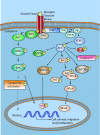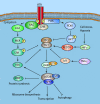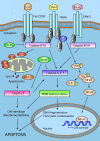Survival signalling and apoptosis resistance in glioblastomas: opportunities for targeted therapeutics
- PMID: 20515495
- PMCID: PMC2893101
- DOI: 10.1186/1476-4598-9-135
Survival signalling and apoptosis resistance in glioblastomas: opportunities for targeted therapeutics
Abstract
Glioblastoma multiforme (GBM) is the most common primary brain tumour in adults and one of the most aggressive cancers in man. Despite technological advances in surgical management, combined regimens of radiotherapy with new generation chemotherapy, the median survival for these patients is 14.6 months. This is largely due to a highly deregulated tumour genome with opportunistic deletion of tumour suppressor genes, amplification and/or mutational hyper-activation of receptor tyrosine kinase receptors. The net result of these genetic changes is augmented survival pathways and systematic defects in the apoptosis signalling machinery. The only randomised, controlled phase II trial conducted targeting the epidermal growth factor receptor (EGFR) signalling with the small molecule inhibitor, erlotinib, has showed no therapeutic benefit. Survival signalling and apoptosis resistance in GBMs can be viewed as two sides of the same coin. Targeting increased survival is unlikely to be efficacious without at the same time targeting apoptosis resistance. We have critically reviewed the literature regarding survival and apoptosis signalling in GBM, and highlighted experimental, preclinical and recent clinical trials attempting to target these pathways. Combined therapies simultaneously targeting apoptosis and survival signalling defects might shift the balance from tumour growth stasis to cytotoxic therapeutic responses that might be associated with greater therapeutic benefits.
Figures



Similar articles
-
Furanodienone overcomes temozolomide resistance in glioblastoma through the downregulation of CSPG4-Akt-ERK signalling by inhibiting EGR1-dependent transcription.Phytother Res. 2019 Jun;33(6):1736-1747. doi: 10.1002/ptr.6363. Epub 2019 Apr 21. Phytother Res. 2019. PMID: 31006910
-
Deregulated signaling pathways in glioblastoma multiforme: molecular mechanisms and therapeutic targets.Cancer Invest. 2012 Jan;30(1):48-56. doi: 10.3109/07357907.2011.630050. Cancer Invest. 2012. PMID: 22236189 Free PMC article. Review.
-
Anti-epidermal growth factor receptor therapy for glioblastoma in adults.Cochrane Database Syst Rev. 2020 May 12;5(5):CD013238. doi: 10.1002/14651858.CD013238.pub2. Cochrane Database Syst Rev. 2020. PMID: 32395825 Free PMC article.
-
Aptamer targeting EGFRvIII mutant hampers its constitutive autophosphorylation and affects migration, invasion and proliferation of glioblastoma cells.Oncotarget. 2015 Nov 10;6(35):37570-87. doi: 10.18632/oncotarget.6066. Oncotarget. 2015. PMID: 26461476 Free PMC article.
-
Targeting EGFR for treatment of glioblastoma: molecular basis to overcome resistance.Curr Cancer Drug Targets. 2012 Mar;12(3):197-209. doi: 10.2174/156800912799277557. Curr Cancer Drug Targets. 2012. PMID: 22268382 Free PMC article. Review.
Cited by
-
ABT-737 promotes tBid mitochondrial accumulation to enhance TRAIL-induced apoptosis in glioblastoma cells.Cell Death Dis. 2012 Nov 29;3(11):e432. doi: 10.1038/cddis.2012.163. Cell Death Dis. 2012. PMID: 23190604 Free PMC article.
-
CHOP and caspase 3 induction underlie glioblastoma cell death in response to endoplasmic reticulum stress.Exp Ther Med. 2012 Mar;3(3):487-492. doi: 10.3892/etm.2011.422. Epub 2011 Dec 19. Exp Ther Med. 2012. PMID: 22969916 Free PMC article.
-
Broad targeting of resistance to apoptosis in cancer.Semin Cancer Biol. 2015 Dec;35 Suppl(0):S78-S103. doi: 10.1016/j.semcancer.2015.03.001. Epub 2015 Apr 28. Semin Cancer Biol. 2015. PMID: 25936818 Free PMC article. Review.
-
Novel approaches for glioblastoma treatment: Focus on tumor heterogeneity, treatment resistance, and computational tools.Cancer Rep (Hoboken). 2019 Dec;2(6):e1220. doi: 10.1002/cnr2.1220. Epub 2019 Nov 11. Cancer Rep (Hoboken). 2019. PMID: 32729241 Free PMC article.
-
PLK1 inhibition promotes apoptosis and DNA damage in glioma stem cells by regulating the nuclear translocation of YBX1.Cell Death Discov. 2023 Feb 17;9(1):68. doi: 10.1038/s41420-023-01302-7. Cell Death Discov. 2023. PMID: 36805592 Free PMC article.
References
-
- Stupp R, Hegi ME, Mason WP, van den Bent MJ, Taphoorn MJ, Janzer RC, Ludwin SK, Allgeier A, Fisher B, Belanger K. Effects of radiotherapy with concomitant and adjuvant temozolomide versus radiotherapy alone on survival in glioblastoma in a randomised phase III study: 5-year analysis of the EORTC-NCIC trial. Lancet Oncol. 2009;10:459–466. doi: 10.1016/S1470-2045(09)70025-7. - DOI - PubMed
Publication types
MeSH terms
Substances
LinkOut - more resources
Full Text Sources
Other Literature Sources
Medical
Research Materials
Miscellaneous

